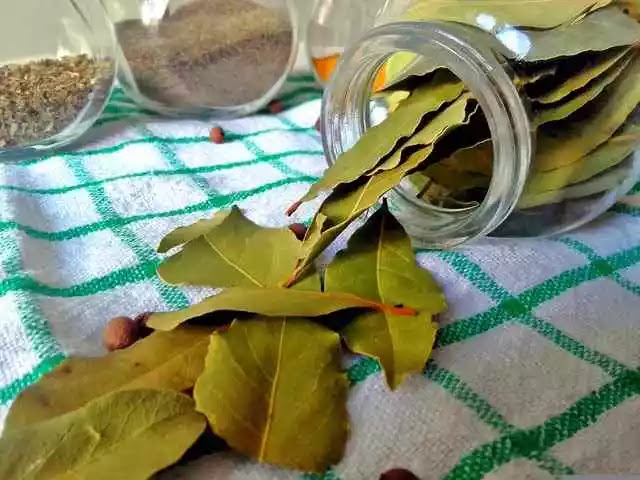Bay leaf are used in Indian cooking a lot. Coming from the family of Lauraceae its leaves belong to Cinnamomum Tamala plant and are mostly used in dried form. They are called tej patta in Hindi. The plant can reach height up to 66ft and the fresh leaves are long in length with three large vein in between. To reap the benefits and extract their full flavours they should be crushed before adding to the recipe.
Their taste is somewhat similar to cloves. Tej patta have strong taste, and along with numerous other Indian spices the aroma becomes even more distinct than flavour. One will not find their cultivation on a large scale like other plants and they mostly grow in the wild mainly in Nepal, Bhutan and Eastern parts of India.
Tej patta are added in the beginning of the cooking so that all the flavours hidden in it merge with the dish that is being prepared. One can also see the use of bay leaf in soup, biryani etc. They are not only used in Indian cuisine but also in European and American cuisine.
What are the other names of Tej patta?
Cinnamomum tamala, Develee, Tejpatra, Tamalapatra, Dalchini Ele, Dalchini pan, Tajpatra, Karuvapatta patram, Tamalpatra, Tejapatra, Tajpater, Lavangapatri, Akupatri, Tezpat.
Reference: https://www.1mg.com/ayurveda/tejpatta-36
What is the source of Tej patta?
Plant Based
Reference: https://www.1mg.com/ayurveda/tejpatta-36
Benefits of Tej patta
Good digestive
Tej patta prevents one from numerous digestive problems like constipation, bloating, abdominal pain etc. The compounds found in bay leaf provides relief from upset stomach.
Antioxidant properties
Tej patta has antioxidant properties which comes from vitamin C and E present in it. It helps to lower the cholesterol by providing protection against free radical cells which can affect liver and kidneys.
Healthy heart
Two compounds found in tej patta improves the heart health. They are rutin and caffeic, rutin strengthens the veins present in the heart and caffeic aids in lowering LDL or bad cholesterol.
Healthy for brain
Bay leaf extracts has relaxing properties which affects the mood of a person. It also reduces the anxiety and makes the person calm.
Acts as an insect repellent
Lauric acid found in tej patta may act as an insect repellent which keeps away the mosquitoes. More research needs to be done in this area to establish this fact.
Healing properties
The antioxidant properties and anti-microbial properties found in bay leaf may accelerate the healing process.
Reference: https://www.healthifyme.com/blog/benefits-of-bay-leaf/
https://pharmeasy.in/blog/ayurveda-benefits-side-effects-precautions-nutritional-value-of-tejpatta/
Where to buy bay leaf?
They are readily available in grocery stores and supermarkets in fresh and dried form. One can also purchase them online from some of the popular e commerce platforms such as amazon, flipkart and eBay etc. While fresh bay leaves may not be readily available, dried bay leaf comes in a jar.
Frequently asked questions (FAQs)
Q.) Is tej patta and bay leaf same?
Ans.) Yes, both are same. Tez patta is Hindi term for bay leaf.
Q.) Does Bay leaf come from same family of cinnamon?
Ans.) Bay leaf comes from bay laurel and cinnamon comes from Cinnamon tree.
Q.) Which part of India are they found the most?
Ans.) They are found in North eastern states of India like Sikkim, Meghalaya, Mizoram and Tripura.
Q.) Are they cultivated commercially?
Ans.) No, they are not cultivated commercially and grow in the wild.
Q.) How to store bay leaf?
Ans.) Store them in a clean, dry and an air tight container.
Q.) Why do we need to take out bay leaf before serving?
Ans.) The leaf doesn’t soften after cooking and in order to prevent choking it is removed before the dish is served.
Conclusion
Bay leaf is used in Indian cuisine to add flavour and aroma to the dish.
Bay leaf comes from the family of Lauraceae its leaves belong to Cinnamomum Tamala plant and are mostly used in dried form.
The plant can reach height up to 66ft and the fresh leaves are long in length with three large vein in between. To reap the benefits and extract their full flavours they should be crushed before adding to the recipe. Their taste is somewhat similar to cloves.








0 Comments
Leave your valuable feedback please